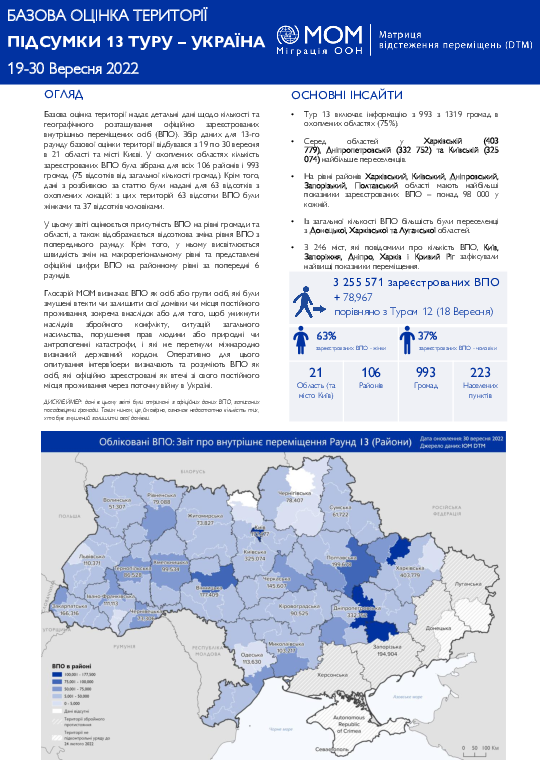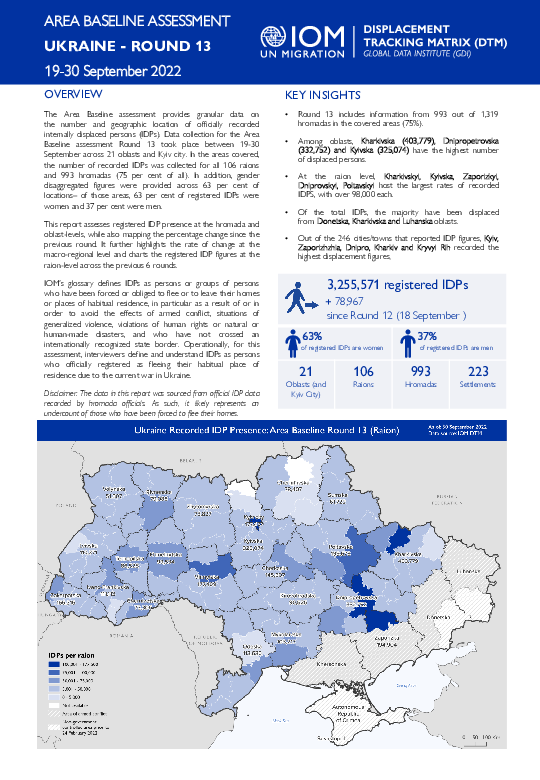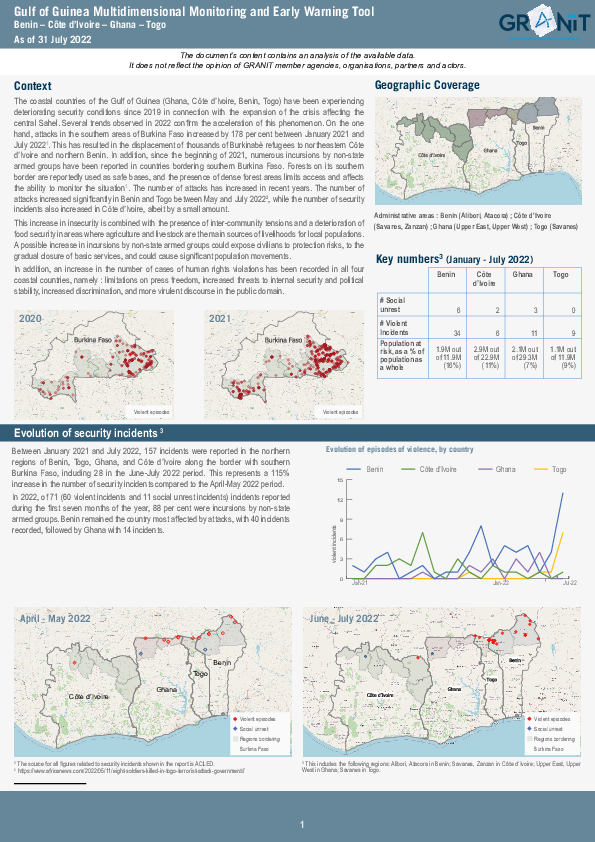-
Countries
-
Data and Analysis
-
Special Focus
-
Crisis Responses
Contact
DTM Yemen, iomyemendtm@iom.int
Location
Yemen
Activity
- Displacement Solutions
Period Covered
Jan 01 2020 -Dec 31 2020
The International Organization for Migration (IOM) Displacement Tracking Matrix (DTM) is a global information system composed of a set of tools and methodologies that contribute to defining the number and needs of displaced people, migrants, returnees and host community members throughout Yemen. The DTM team uses Rapid Displacement Tracking (RDT) to collect data on the number of Yemeni households forced to flee on a daily basis due to conflict, natural disaster or other reasons. This allows DTM to produce regular reporting of occurrences of displacement in terms of numbers, locations and needs. However, RDT data does not capture whether displacement is new or repeat (households displaced from another displacement location). RDT methodology has been in use to track internally displaced persons (IDPs) and returnees between January and December 2020.
DTM identified 172,386 individuals (28,731 households) who were displaced, mainly by the conflict, across 13 governorates, 118 districts and over 1,249 locations in Yemen during 2020. As mentioned above, this data only represents displacement events in 2020, and does not include people that were displaced in previous years and are still displaced to date. DTM’s data is not representative of all displacement occurring in Yemen and should therefore be understood as indicative of the areas in which IOM has access.
The first COVID-19 case in Yemen was reported in April 2020, followed by precautionary movement restrictions, which directly limited IDPs’ access to humanitarian assistance. In addition to IOM’s inaccessibility, COVID-19 related restrictions prevented data collection in some areas and may have contributed to the decreased levels of displacement observed in 2020. However, it remains clear that non-pandemic causes such as conflict, natural disaster and the challenging socio-political situation all continued to contribute to displacement through 2020.
Population Groups
Survey Methodology
Unit of Analysis Or Observation
Type of Survey or Assessment
Keywords
Geographical Scope
Administrative boundaries with available data
The current dataset covers the following administrative boundaries

Contact
DTMMozambique@iom.int
Language
English
Location
Mozambique
Period Covered
Oct 09 2022
Oct 10 2022
Activity
- Mobility Tracking
- Event Tracking
Fear of attacks, confirmed attacks by Non-State Armed Groups in Macomia district (Nguida locality) triggered 661 individual
displacement movements from Nuida to Macomia sede. An estimate of 64 Internally Displaced Persons (IDPs) have been identified with vulnerabilities. 56% of recorded movements represent individuals displaced for the first time, 17% for the second time and 27% represent at least three times.
IOM teams observed an average of 331 individuals arriving at different locations within the reporting period (09 - 10 October) Movements in the region remain dynamic between host communities. The objective of the Emergency Tracking Tool (ETT) - Movement Alert is to collect information on large and sudden population movements, and to provide support to the humanitarian response partners by disseminating data on IDPs to support effective humanitarian response to the affected population. Information is collected through key informants interviews or direct observation.

Contact
DTMUkraine@iom.int
Language
Ukrainian
Location
Ukraine
Period Covered
Sep 19 2022
Sep 30 2022
Activity
- Baseline Assessment
Базова оцінка території надає детальні дані щодо кількості та географічного розташування офіційно зареєстрованих внутрішньо переміщених осіб (ВПО). Збір даних для 13-го раунду базової оцінки території відбувався з 19 по 30 вересня в 21 області та місті Києві. У охоплених областях кількість зареєстрованих ВПО була зібрана для всіх 106 районів і 993 громад (75 відсотків від загальної кількості громад). Крім того, дані з розбивкою за статтю були надані для 63 відсотків з охоплених локацій: з цих територій 63 відсотки ВПО були жінками та 37 відсотків чоловіками.
У цьому звіті оцінюється присутність ВПО на рівні громади та області, а також відображається відсоткова зміна рівня ВПО з попереднього раунду. Крім того, у ньому висвітлюється швидкість змін на макрорегіональному рівні та представлені офіційні цифри ВПО на районному рівні за попередні 6 раундів.

Contact
DTMUkraine@iom.int
Language
English
Location
Ukraine
Period Covered
Sep 19 2022
Sep 30 2022
Activity
- Baseline Assessment
The Area Baseline assessment provides granular data on the number and geographic location of officially recorded internally displaced persons (IDPs). Data collection for the Area Baseline assessment Round 13 took place between 19-30 September across 21 oblasts and Kyiv city. In the areas covered, the number of recorded IDPs was collected for all 106 raions and 993 hromadas (75 per cent of all). In addition, gender disaggregated figures were provided across 63 per cent of locations– of those areas, 63 per cent of registered IDPs were women and 37 per cent were men.
This report assesses registered IDP presence at the hromada and oblast-levels, while also mapping the percentage change since the previous round. It further highlights the rate of change at the macro-regional level and charts the registered IDP figures at the raion-level across the previous 6 rounds.
The early warning and monitoring tool on the situation in the Gulf of Guinea coastal countries (Ghana, Benin, Togo and Côte d'Ivoire), as of 31 July 2022, developed by the GRANIT under the direction of OCHA, IOM and REACH, monitors, based on data and analysis provided by humanitarian and development partners, trends relative to key indicators relating to the situation in the four coastal countries, as of 31 July 2022.
This report examines the evolution, over the first five months of 2022, of the situation in Ghana, Togo, Benin and Côte d'Ivoire in terms of :
- Security incidents
- Types and frequency of violence
- Forced displacement of IDPs and Refugees
- Operational status of international borders
- Food security
- Community dynamics
- Human rights

Contact
iombeirut@iom.int
Language
English
Location
Lebanon
Period Covered
May 01 2022
Jul 31 2022
Activity
- Migrants presence
- Mobility Tracking
- Baseline Assessment
This report presents the findings from IOM's Migrant Presence Monitoring (MPM) Round 2 data collection exercise conducted in Lebanon. Data collection took place between May and July 2022 and covered all districts in Lebanon. Through annual rounds, the MPM seeks to systematically assess geographic areas in Lebanon to quantify the presence of migrants. The information is used to support humanitarian assistance, coordination, and planning. The MPM relies on key informants who are mostly composed of migrant community representatives, Mukhtars, and Municipality officials, to provide reliable information in their geographical area. The assessed areas are small enough to ensure that the information collected is as detailed, precise, and reliable as possible. As during the 2021 MPM, data was collected on population size (number of migrants) and nationalities. The 2022 MPM also collected sex and age disaggregated data.
The information from IOM-MPM's findings, complementary to data from past assessments, aims to enable partners across the international community and Lebanese partners to have access to an evidence base on migrant presence, to support well-informed, targeted, and coordinated response. The complementary evidence generated from the MPM exercise also serves as a baseline and tertiary source for triangulation for other data collection exercises. For example, MPM data was used to develop of a sampling frame of migrants for the Multi-Sectorial Needs Assessment (MSNA) 2021 and 2022 exercises led by the Humanitarian Country Team (HCT).
The MPM assessment follows the methodology of IOM’s global Displacement Tracking Matrix (DTM) Mobility Tracking component. Tailored to the operational context in Lebanon, the MPM assessment analyzes data to provide multi-layered information on the presence and mobility of migrants. This assessment aims to complement existing data collection exercises and it is implemented in coordination with key actors to maximize synergies, interoperability and avoid duplication.

Contact
DTM Europe, DTMMediterranean@iom.int
Language
English
Location
Republic of Moldova
Period Covered
Feb 24 2022
Oct 02 2022
Activity
- Flow Monitoring
- Migrants presence
Between 24 February and 2 October 2022, Ukrainian refugees represented 90 per cent (579,582) of all individuals registered at entry from Ukraine (UKR) to the Republic of Moldova (MDA). The remaining 10 per cent (63,867) were Third Country Nationals (TCNs). Similarly, Ukrainian refugees represent 89 per cent (301,971) of all individuals registered leaving the Republic of Moldova towards Romania (ROU) during the reporting period and the remaining 11 per cent (35,730) were TCNs. This report focuses on the observable trends in the data on TCNs who entered the Republic of Moldova from Ukraine and analyzes data concerning their stay or their subsequent movement out of the country.
Contact
DTM Libya, DTMLibya@iom.int
Language
English
Location
Libya
Snapshot Date
Sep 25 2022
Activity
- Site Assessment
Detention Centre Profiling is a component of IOM Libya’s Displacement Tracking Matrix programme. It is a data oriented tool that routinely provides disaggregated sex and age data and key sectoral information on migrants in Libya’s detention centres on the date of assessment.

Contact
DTM Sudan; dtmsudan@iom.int
Language
English
Location
Sudan
Snapshot Date
Sep 20 2022
Activity
- Mobility Tracking
- Event Tracking
The DTM Emergency Event Tracking (EET) is deployed to track sudden displacement and population movements, provide more frequent updates on the scale of displacement, and quantify the affected population when needed. As a subcomponent of the new Mobility Tracking methodology in Sudan (Round Four), and activated on a need basis, EET utilises a broad network of key informants to capture best estimates of the affected population presence per location – a useful tool for humanitarian response planning and design.
